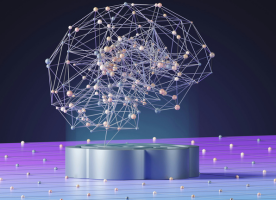19 August 2025
SCION and AI: Trustworthy AI depends on a secure network
Share this post
As artificial intelligence reshapes the digital landscape, the conversation is shifting from capability to trust. It’s no longer just about how powerful AI models are – it’s about how responsibly they operate, how securely they leverage data, and how reliably they scale across borders and ecosystems. We see at the heart of this transformation a non-negotiable: AI should be built on solid foundations, and that starts with a secure, reliable Internet infrastructure. This becomes even more important as AI also becomes an ally of cybercriminals – dramatically shortening the attack lifecycle from the discovery of a zero-day vulnerability to its exploitation. Without reliable and trustworthy networks, even the most advanced AI becomes a liability.
AI and the Internet – an inseparable link in B2B
A challenge in bringing AI to the B2B world, is that it does not operate in a vacuum. It’s part of a digital fabric that connects enterprises, partners, customers, and cloud platforms.
Here’s why secure Internet infrastructure is essential for AI in this context:
Real-time data access: With the advent of real-time AI inference (e.g., industrial robotics, finance), AI systems need to draw on live data with predictable latency. This includes getting data from external partners, IoT devices, financial feeds, or logistics systems.
Cloud-based AI delivery: Most AI services are accessed through the cloud. The Internet is the delivery mechanism for AI-as-a-Service platforms.
Interconnected ecosystems: B2B value chains depend on AI systems talking to one another across suppliers, platforms, and customers. These interactions rely on stable, secure Internet paths.
Compliance and data security: Whether in finance, healthcare, or energy, AI systems often process sensitive data. The communication layer must meet security, sovereignty, and reliability requirements.
In short, AI needs connectivity to operate – and it needs better connectivity to operate securely and reliably.
A shift toward smaller, localized AI models
Gone are the days of one-size-fits-all, large and centralized AI systems. As regulatory demands tighten and privacy concerns grow, AI is becoming more localized and specialized. Models are being tailored to specific geographies, industries, and use cases – trained and fine-tuned using sensitive local data.
This decentralization brings benefits: faster performance, better contextual understanding, and enhanced compliance with data sovereignty laws. But it also introduces complexity. Each localized AI model must now communicate with a growing number of external systems, APIs, and data sources – often across multiple jurisdictions and networks.
To remain current, useful, and safe, future AI systems will not operate in isolation. They will continuously draw data across a distributed ecosystem of partners – financial institutions, cloud providers, infrastructure operators, logistics networks, and more. This constant exchange of information needs to be secure, resilient, and tamper-proof.
Unfortunately, the traditional Internet has some gaps in terms of availability, and data residency. AI workloads depend on real-time access to data and services across organizations, but underlying connectivity is brittle, and susceptible to network level attacks, hijackings, and other forms of network-level disruption.
If AI is to be trustworthy, its communication infrastructure must be trustworthy first.
AI – an ally of cybercriminals
As with every technology, AI is getting quickly adopted by cybercriminals too, reshaping the threat landscape. According to the Vulncheck Q1 2025 report, the average time it takes for a vulnerability to be exploited after disclosure has drastically decreased in recent years, with nearly one third of known vulnerabilities being exploited in less than 24 hours. What once took months for attackers to exploit can now take only days. On top of that, AI-driven tools and automation can quickly scan and analyse enterprise systems to uncover vulnerabilities that might otherwise go unnoticed.
Within such an evolved threat landscape, business leaders need to recognize the importance of additional defences that can reduce the attack surface of devices connected to the Internet. Perimeter defenses are increasingly affected, demanding complementary solutions.
Enter SCION: Predictable latency and data paths, with high security and availability
This is where SCION comes in. SCION can help support communication with multiple partners to be secure and reliable as well as reduce the attack surface of the network so that AI doesn’t give unfair advantages to malicious attackers.
Within the SCION network, participants can join only through strict governance procedures. This reduces the attack surface and ensures that services on the network are visible only where they need to be.
Cryptographically verifiable paths: AI systems benefit from predictable latency, and guarantee where data is coming from and where it’s going – eliminating route spoofing or hijacking risks.
Multipath and multi-operator communication: SCION ensures reliability even in the face of network outages or attacks.
Fine-grained routing control: Organizations can meet strict compliance or localization requirements by choosing data paths that stay within specific jurisdictions.
Building a trustworthy future
As AI matures, trust will be its currency – and that trust must extend from model to machine to network. We stand for an Internet that can support not just the power of AI, but also its promise: to serve society reliably, ethically, and transparently.
With SCION, we’re laying the foundation for a secure digital backbone that AI can build on.
